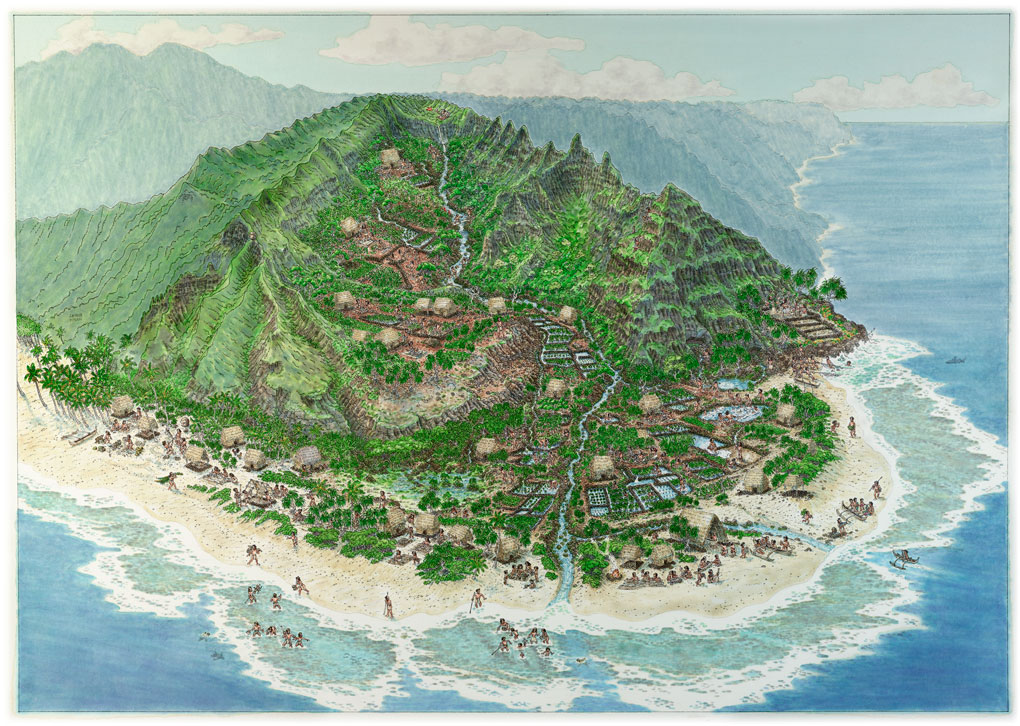
Today, Hawaii imports 90% of its food.
Before Captain Cook landed, the populous Native Hawaiians were entirely self-sufficient and produced more food using less land than modern Hawaiian agriculture.
Here is a quick tour.
Before Captain Cook landed, the populous Native Hawaiians were entirely self-sufficient and produced more food using less land than modern Hawaiian agriculture.
Here is a quick tour.

Native Hawaiians developed the ahupua'a system, a geographic unit used to delineate a specific land management and food production area.
Each ahupua'a started as a narrow point high in the the volcanic peaks, spreading wider like a slice of pie as it descended towards the sea.
Each ahupua'a started as a narrow point high in the the volcanic peaks, spreading wider like a slice of pie as it descended towards the sea.

A single ahupua'a spanned a cross-section of the island’s ecosystems and resources.
The ahupua'a was organized around the flow of water. Boundaries ran along the natural delineation of watersheds. From the top of the system to the bottom, water was treated with the utmost care.
The ahupua'a was organized around the flow of water. Boundaries ran along the natural delineation of watersheds. From the top of the system to the bottom, water was treated with the utmost care.

The upper forests were mostly untouched, with a small portion lightly managed and used to produce hardwoods and building materials
Below this area, Native Hawaiians planted agroforestry plots mixing endemic plants with the canoe plants brought by the first Polynesians
Below this area, Native Hawaiians planted agroforestry plots mixing endemic plants with the canoe plants brought by the first Polynesians

Breadfruit trees and coconut trees shaded bananas and noni trees, and sprinkled throughout the agroforest were Kukui trees. Chickens and pigs ate the fallen fruits.
This served as the Hawaiians' perennial source of starches, fats, protein, and medicinals.
This served as the Hawaiians' perennial source of starches, fats, protein, and medicinals.

In the zone below the agroforestry, Hawaiians grew their most important staple and culturally significant crop: taro
This zone was terraced and irrigated with water from the mountain streams. Water was diverted into the terraced pools, gently spilling from one to the next
This zone was terraced and irrigated with water from the mountain streams. Water was diverted into the terraced pools, gently spilling from one to the next

Excess water would return to the stream, where it continued towards the sea.
The freshwater would eventually meet the sea and spill into rock-walled fish ponds in the tidal pools. Fish were captured with sluice gates and fattened up in the nutrient-rich brackish water
The freshwater would eventually meet the sea and spill into rock-walled fish ponds in the tidal pools. Fish were captured with sluice gates and fattened up in the nutrient-rich brackish water

A recent study concluded that the ahupua'a system could produce 1 million metric tons of food from just 6 percent of Hawaii's land.
That's enough to feed all of the estimated 1.2 million pre-contact Native Hawaiians, or 86% of the current population of Hawaii, 1.4 million.
That's enough to feed all of the estimated 1.2 million pre-contact Native Hawaiians, or 86% of the current population of Hawaii, 1.4 million.
In contrast, Hawaii's current farmland covers 3x more land than before 1777, and the total food produced through modern methods is only 151,700 metric tons
That's only 15% of what was produced more than 200 years ago by Native Hawaiians on 3x less land without external inputs
That's only 15% of what was produced more than 200 years ago by Native Hawaiians on 3x less land without external inputs
The ahuapua'a system was first conceived around the 15th century. It was successfully used for more than 1,000 years to produce a cornucopia of foods, maximize and sustain precious water resources, preserve a rich ecology, and support a vibrant culture.
Today, we go straight for the shiny technological fix; we've lost track of the whole and focus too much on the individual pieces, resulting in fragile agriculture systems
The ahuapa'a is an example of the kind of agricultural ingenuity that is possible in each unique bio-region
The ahuapa'a is an example of the kind of agricultural ingenuity that is possible in each unique bio-region
The second to last tweet should read: The ahuapua'a system is believed to have been conceived in the 15 century. However, some evidence shows that it was successfully used for over 1,000 years.
Thanks to all who pointed out my math deficiency. I also mix up my colors.
Thanks to all who pointed out my math deficiency. I also mix up my colors.
• • •
Missing some Tweet in this thread? You can try to
force a refresh












